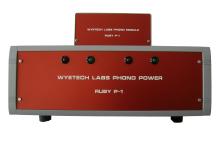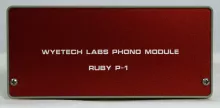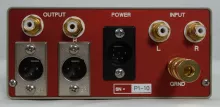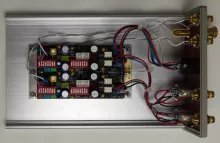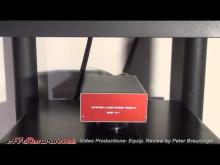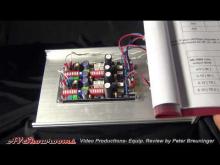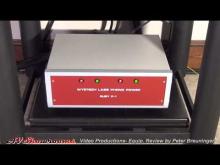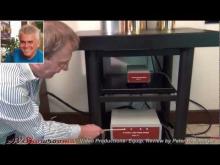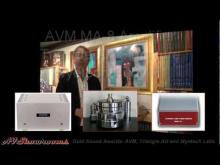Reference phono stage preamplifier
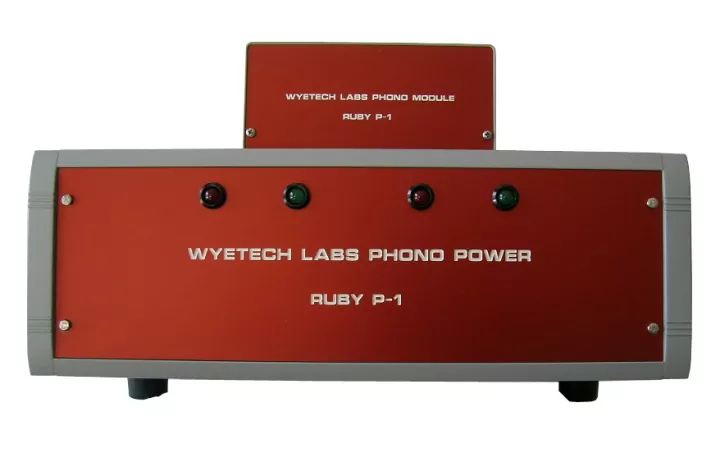
The Ruby P-1 is a two-channel phono preamplifier module with very accurate RIAA equalization and many features. It is realized with the best semiconductors available and non-inductive, low noise, SMD metal film resistors. The circuit is designed to accept both moving coil (MC) and moving magnet (MM) transducers/cartridges directly in order to eliminate the need for an external MC step-up transformer or amplifier. MC/MM input loading, gain and input capacitance values are easy to select with high resolution DIP switches.
The Module is ideal for the most demanding applications requiring accurate RIAA equalization, very low noise, extremely low distortion and superior sonic performance.
Videos
Circuit Description
The Ruby P-1 module has been custom-built for Wyetech Labs by completely automated state of the art assembly methods using extremely precision components with tolerances to 0.1% accuracy.
Wyetech Labs has employed dual completely independent plus and minus power supplies for each channel rendering the most accurate level attainable by any means. (far outperforms battery supply operation)
Shunt regulation in DC power supply
The Niagara river produces enormous power while still allowing some water to flow over the falls to maintain the beauty of it and allow it to be a world attraction. It only consumes a portion of the water flow to meet these dual requirements.
It is the equivalent to Shunt Regulation in audio power supplies and specifically in the Ruby Phono power supply.
The power supply is designed to produce more power than what is actually needed while the surplus power is dissipated as heat in order to maintain a precise voltage to the amplifier itself. The amplifier drains the current ( power ) from the power supply as needed which can vary depending on the signal output, while fixating the VOLTAGE to a precise level to eliminate any modulation of the actual audio voltage signal.
The dual red / green LEDs show the operation of these four circuits. The LEDs monitor this excess current which flows through each of them such that they become the status of the proper operation. They should always be lit but the intensity of the light output could vary depending on the AC voltage fed to it. Low AC input voltage can cause the LEDs to turn off. The green LED will shut down first then the red if the AC voltage continues to sag further. Even if this happens you will not find any deterioration in sound because the +/- 26 volt DC output is further reduced to +/- 16 volts by an onboard regulator on the analog PCB module. Notwithstanding in proper operation they should always be lit up if your input AC is operating at the proper AC voltage.
In other words the amplifying circuit is always supplied with the power it needs which can vary with the signal while the excess power is dissipated through the ground as heat. This type of regulation is called shunt regulation and is considered to be far superior to a series type regulator which is why we chose to implement it in this product.
Secondary DC regulators on the analog module further reduce the voltage to +/- 16 volts for each channel from the +/- 26 volts feeding it. This double regulation further reduces any possibility of noise or distortion in the analog module.
Features
- Compact design. Dual-mono. Very low noise. Single or Balanced output
- Non-inductive low noise SMD metal film resistors (0.1%)
- Input accepts moving coil/moving magnet (MC/MM) cartridges directly without step-up transformer
- Input loading: from 10 ohms to 47k ohms selectable in 21 steps
- Gain Select: 40 dB to 80 dB selectable in 34 steps
- High output drive. Balanced - 28V. Unbalanced - 14V
- High accuracy RIAA equalization with 0.05dB tolerance
- Selectable time constants of 3.18 μs and/or 7950 μs
- Total harmonic distortion 0.0003%
- Low output impedance ( 0.1 Ohm ) - drives long signal cables
- Two-stage dual-supply voltage regulator on PCB board for each channel in combination with external DC power supply
- Three-stage outboard power supply with 6 chokes and over 40,000 uf of filtering capacitance
Specifications
DC Electrical Characteristics
| Symbol, parameter | (conditions / comments) | Value | Unit |
| RIN, input resistance | (DIP-switch selectable) | 10, 15, 18, 20, 25, 30, 40, 50, 60, 70, 80, 90, 100, 150, 180, 200, 250, 400, 600, 1k, 47k | Ohm |
| CIN, input capacitance | (DIP-switch selectable) | Approx. 100, 200, 300, 400 | pF |
| IB, input bias current | (Input bias current cancellation pre-adjusted) | Max. 0.5 | uA |
| PSRR, power supply rejection ratio | (AV = 40dB, 10Hz to 20kHz) | 120 | dB |
| RO, output resistance | (VO = 1V, DC to 100kHz) | 0.1 | Ohm |
| VO, output voltage swing | (Unbalanced operation) | Min. 14.2 | V |
| IO, output current | (RL = 100 Ohm) | 25 | mA |
| IS, supply current | (Each channel) | 22 | mA |
AC Electrical Characteristics
| Symbol, parameter | (conditions / comments) | Value | Unit |
| VIN, input nominal levels | (VO = 1V) (DIP-switch selectable)(0.10mV ~ AV = 80dB)(1.0mV ~ AV = 60dB)(10mV ~ AV = 40dB) | 0.10, 0.12, 0.15, 0.18, 0.20, 0.25, 0.30, 0.40, 0.45, 0.50, 0.55, 0.60, 0.70, 0.80, 0.90, 1.0, 1.1, 1.2, 1.3, 1.4, 1.5, 1.6, 1.8, 2.0, 2.5, 3.0, 3.5, 4.0, 4.5, 5.0, 7.0, 8.0, 9.0, 10.0 | Mv |
| VINO, input overload level | (f = 1kHz, AV = 40dB) | 100 | mV |
| AV, voltage gain | (DIP-switch selectable) | 40 to 80 | dB |
| dAV, RIAA equalization deviation | (Ref.= 1kHz, 10Hz to 20kHz) | 0.05 | dB |
| BW, bandwidth | (-3dB, VO = 1V, AV = 40dB) | 2 | MHz |
| en, input noise voltage density | (f0 = 1kHz, AV = 80dB) | 0.5 | nV/Hz |
| S/N, signal to noise ratio | (AV = 40/60/80dB) | 98/90/71 | dB |
| CS, channel separation | (AV = 40dB, 10Hz to 20kHz) | 120 | dB |
| THD, total harmonic distortion | (AV = 40dB, f0 = 1kHz) | 0.0003 | % |
Reviews
The Audio Beat
August 11, 2004 - Reviewed by Ken Choi
The Ruby P-1 phono stage was reviewed in The Audio Beat along with the Ruby STD line stage.
very clean, spooky quiet, and transparent… but not sterile
…it did full justice to whatever was on the record.
Although I’ve certainly not come close to auditioning every phono stage available, the Ruby P-1 is the finest I've heard in my system.
AVShowrooms
November 2012 - Reviewed by Peter Breuninger
Peter Breuninger released a four part review, including an interview with Wyetech Labs founder and designer Roger Hebert, on YouTube.
Designer Roger Hebert has created what may be the world’s finest phono stage for low output moving coils.
The hallmark of the Ruby is its low noise floor, it is DEAD quiet.
The 3D effect is extraordinary with this unit- almost tube like without the noise and with the frequency response that only SS can provide. It’s the best phono stage at this price point I’ve yet to experience.
High-End Audio
December 2017 - Reviewed by Arthur Salvatore
The Wyetech Ruby is the finest solid-state phono stage I have ever heard and it is also the most versatile…
The Ruby's sonic performance is easy to describe: It is very fast, detailed, clean, quiet and neutral.
The Ruby is also the most flexible phono stage I've yet experienced; in gain, loading and filtering, and it is user friendly in all those areas.
Warranty
Note that due to the passing of Roger Hebert, we are no longer able to offer warranty coverage on new sales. The sale price has been adjusted accordingly. Sales made previous to January 2022 will have the waranty coverage period honoured.
Warranty coverage for sales prior to January 2022:
Tubes and components: 5 years parts and labor
